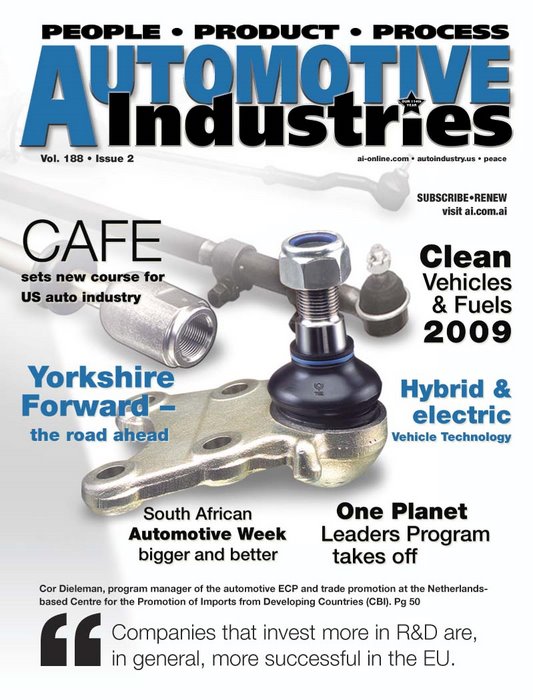
INTERVIEW The Netherlands-based Centre for the Promotion of Imports from Developing Countries or CBI, estimates that the European Union market for automotive parts and components is estimated to be over 300 billion Euros annually (figures for 2006). The CBI’s main mission is to expand EU markets for countries that want to sell their goods and services to the region.
One way the CBI achieves this goal is encouraging companies to take part in trade fairs in Europe. In April this year for example, the CBI took part in Hannover Messe, where despite a dip in visitors compared to last year, CBI participants managed to showcase their products. This translated to orders worth over half a million Euros for the participants. In October this year, the CBI will participate in the EquipAuto 2009 trade fair in Paris where companies that participated in the CBI’s export coaching program for mobile equipment parts, will exhibit their products.
The CBI, which was founded in 1971, holds export coaching programs or ECPs for exporters from developing countries. Last month, the CBI said that its program for the mobile equipment industry which lasted from 2000 to 2007 resulted in an export turnover of 4.5 million to the EU for participants and another 9 million Euros to other markets.
“The overall objective of the program was to help companies from selected DCs to enter the OEM and after market in the EU/EFTA. Almost 80 per cent of them did realize export turnover, with an annual average of almost Euro 500,000 – significantly higher than the targeted Euro 60,000 average. Half of these companies also met the target of realizing at least 50 per cent of their exports on EU/EFTA markets. Another CBI target was to make sure 60 per cent of the successful companies would still be active on the respective export markets 2 years after their last participation in a CBI market entry activity, such as a trade fair,” says the CBI.
The CBI is currently holding an ECP for automotive parts which started in 2008 and will end in 2013. The CBI points out that despite the recession which has hit demand in the OEM segment, demand in the aftermarket is expected to increase. And more and more European companies are looking for reliable suppliers in emerging markets.
“A continuing trend in the automotive industry is that companies source parts and accessories globally. Especially labor-intensive production of parts has moved to low-cost countries. This means there are good opportunities for aspiring exporters. The only question is – how do you turn them into profitable business? The program which ended in 2007 was quite successful. Participants achieved an average additional turnover of almost Euro 400,000. Through this program some major OEM’s / TierI suppliers have successfully used CBI to acquire new suppliers,” says the CBI.
Participants to this ECP were chosen from Colombia, Egypt, India, Indonesia, Macedonia, Morocco, Pakistan, Philippines, South Africa, Sri Lanka, Thailand, Tunisia, Vietnam, Bosnia-Herzegovina and Serbia.
Automotive Industries spoke to Cor Dieleman, program manager of the automotive ECP as well as program manager, Trade Promotion at the Centre for Promotion of Imports from Developing Countries.
AI: How are automotive imports from developing countries to the EU faring in the current economic situation?
The picture is mixed; if we look at exports: companies who are supplying OEM’s in Europe and USA see their sales dropping. Those who are in the aftermarket are doing quite well.
Depending on country there are also differences; the Indian local market growth is still more than 4%. Many of our Indian participants supply OEM’s in India; in most cases their local sales have been more or less stable or increased somewhat.
AI: What kind of levels of R&D investment do companies from developing countries make and how does this impact how well they do in the EU?
Companies that are doing more investments in R&D are in general more successful in EU.
AI: What kind of progress has been made in advanced low-cost manufacturing in developing countries? What role has CBI played in encouraging this trend?
Especially during this time there is a high pressure on cost reduction. In order to be competitive also companies in the CBI programmes have to look into their cost structure. The CBI experts are advising companies about these aspects.
AI: Have developing countries made a commitment to environmental and low carbon technologies? If so, please give examples of these technologies and how they have been received in Europe.
We are not involved in this. However it is an important issue. Individual companies are working on these issues. We are making companies aware of these. In July 2009 workshops are organized in India together with the Automotive Components Manufacturers Association (ACMA) to provide information on Market Access Requirements for the EU and these aspects are also addressed.
A survey in the Netherlands indicated that Dutch companies find these important aspects when looking for new suppliers.
AI: How has the economic slowdown impacted CBI participation in trade fairs like the Hannover Messe and the Equip Auto shows?
Participation of companies participating in the CBI pavilions is about 50 % less compared with previous years. The results for the companies that participate are promising. Compared with other earlier participations the average number of business contacts was even a bit higher. On top of that the interest, the quality of the visitor, was better, more serious.











More Stories
Meet Rita Case – recipient of 2024 NAMAD Lifetime Achievement Award
How Much Can You Save Annually by Switching to Energy-Efficient Rotary Solenoids
Navigating the Electrifying Future of Automotive Batteries – Insights from Focus CEO on Lithium, Graphene, and Emerging EV Tech Trends